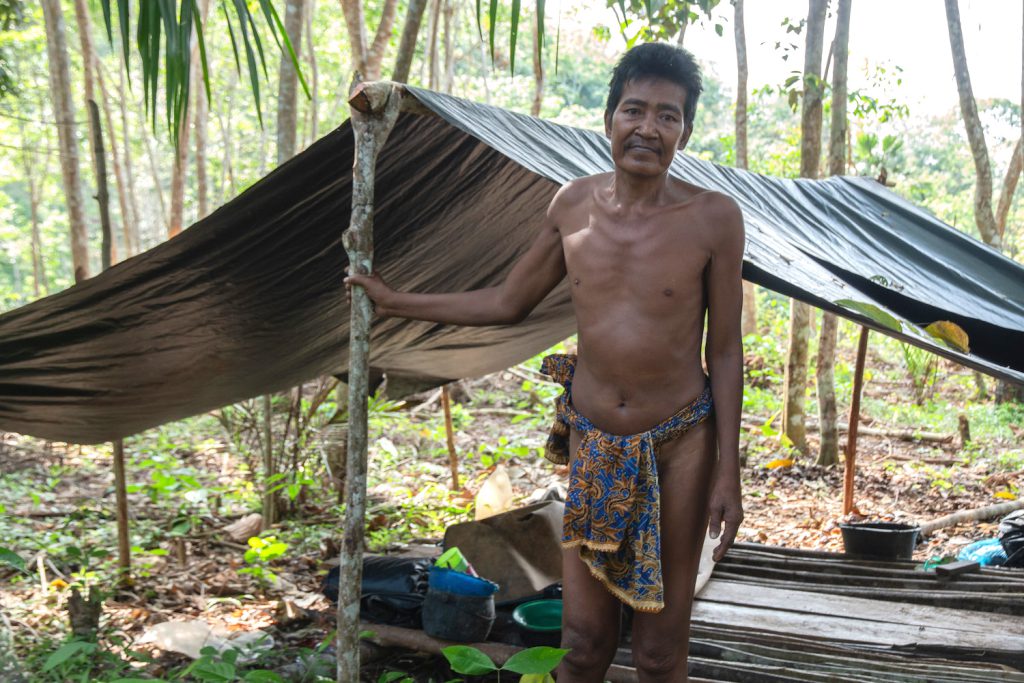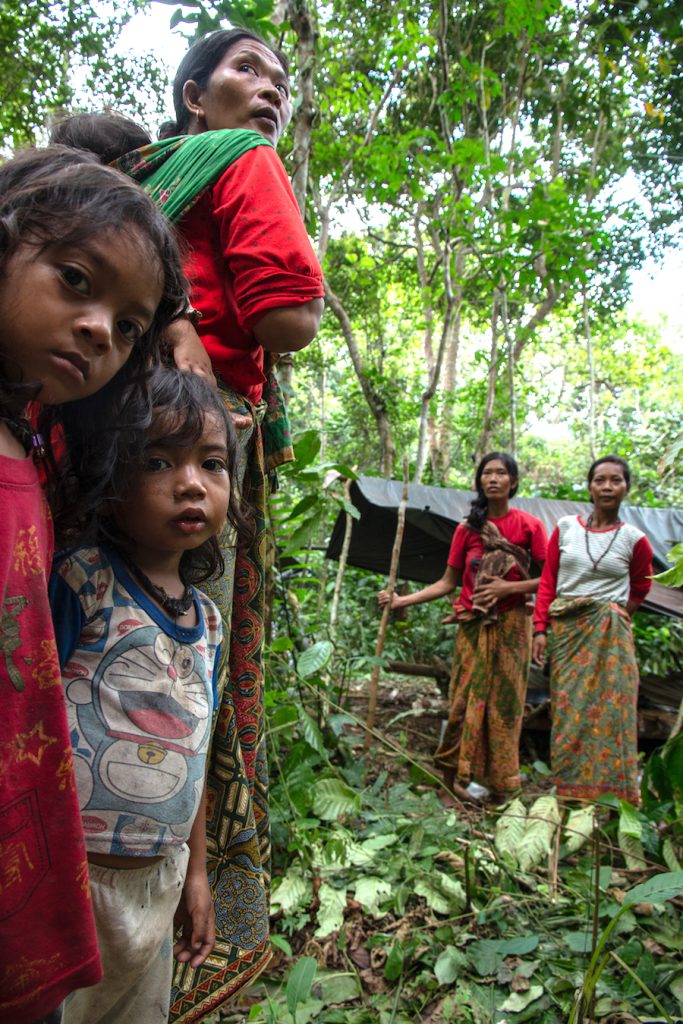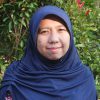Social Distancing in a Sumatra Rainforest

On an otherwise silent night in March 2020, a woman’s wailing cry burst from within a seemingly deserted oil palm plantation in the Bukit Suban village, Jambi, Indonesia. Induk Nyerau, a mother of eight, was crouched down in her traditional wooden tent, suffering from fever and shortness of breath.
As her husband, Meriau, recalls, Induk Nyerau cried all night—afraid and saddened to be left alone. Her children and relatives had abandoned her in the plantation area, fearing she had COVID-19 and would bring the coronavirus to their community. Only Meriau remained, watching her from a 5-meter distance and not daring to get closer.
Meriau and Induk Nyerau are Orang Rimba, one of several hunter-gatherer groups in Indonesia. Living inside and around the rainforest areas in Jambi, on the Indonesian island of Sumatra, this particular group of about 5,000 people maintains a centuries-old social distancing strategy, known as besesandingon, in the face of any disease.
“Gelabah [disease outbreak] is what scares us the most in this world,” Meriau says of the Orang Rimba broadly. He is glad to report that his wife did not have COVID-19. Instead, Meriau notes, she had an ulcer. Still, the couple waited for her full recovery before rejoining their family group, or rombong.
Even during non-pandemic times, every rombong asks outsiders and any Orang Rimba who travel and then return home to stay at least 15 meters away for days before permitting interaction. As part of besesandingon, the Orang Rimba will abandon sick people (as they did with Induk Nyerau), leave the dead, and treat ill individuals from afar by leaving medicines in their vicinity while keeping physically apart.
But besesandingon has become more difficult in recent years as the Orang Rimba’s jungles have been lost to deforestation, limiting each rombong’s space. “This is a typical situation,” says Adi Prasetijo, an anthropologist at Diponegoro University, Semarang, who has studied the Orang Rimba for more than two decades.
The loss of the rainforest has displaced this group and limited their food supply, increasing conflict with outside communities in the process. Prasetijo works with the Indonesian Conservation Community (known as KKI WARSI), a nongovernmental organization that puts anthropological approaches at the forefront of environmental conservation. The organization has been trying to mitigate the impacts of deforestation on the Orang Rimba by providing access to education and health care, and by mediating conflicts with plantation companies.
But without intervention from the government, “the Orang Rimba is currently heading to cultural extinction,” says Prasetijo. And the coronavirus adds even greater urgency to their plight.
The Orang Rimba are deeply opposed to contact with outsiders. The reasons for this avoidance are complex, as Norwegian anthropologist Öyvind Sandbukt first learned in 1979 and 1980, when he visited the Orang Rimba in Jambi.
Sandbukt found that the Orang Rimba see the world as having two different realms. Their name means “forest people” in the group’s language. Everyone else, however, can be seen as outsiders, or Orang Terang, “people of the open.”
“Any attempt to confuse the two domains … would trigger off not only serious misfortune, but ultimately, the end of the world,” he wrote in a 1984 paper about this community.
But Sandbukt, now an adviser to KKI WARSI’s work with the Orang Rimba, had come at a pivotal time: Interactions with the outside world were becoming inevitable for the Orang Rimba. In the four ensuing decades, the rainforest in Jambi would decline drastically as government policies sanctioned clearing it for roads, houses, and monoculture plantations such as oil palm.
The Orang Rimba perceive all Orang Terang as being Muslim, a characteristic that reflects the beliefs of their longest-standing neighbors. Today, however, the “outsiders” include communities of Javanese people who have come to Jambi as part of the government’s transmigration program and researchers and activists such as Sandbukt and Prasetijo.
“Gelabah [disease outbreak] is what scares us the most in this world,” Meriau says of the Orang Rimba broadly.
The Orang Rimba believe the Orang Terang—or anything related to them—bring diseases and death. As a result, all outsiders are shunned. In response, Sandbukt, Prasetijo, and others have applied anthropological approaches to connect with the Orang Rimba over the decades. KKI WARSI staff working with the community may spend weeks or even a month living with the group to learn from them. They also observe social distancing until a rombong permits them to come closer.
This approach has brought important insights. During his own fieldwork, Prasetijo discovered interesting contrasts in how people in Jambi regarded one another. For example, that Malay villagers “looked down on [the Orang Rimba],” he explains, seeing their refusal to leave their lands that had changed from forest to plantation as “stubborn.”
But Prasetijo also found that the Orang Rimba feel tied to specific locations out of respect for their ancestors, whom they believe specified certain spaces for their family. “If one group’s designated area has been turned into oil palm plantations, they could not move back to the forests because it belongs to other rombongs,” he explains.
These cultural observations have helped KKI WARSI communicate the position of the Orang Rimba to others in positions of power in Indonesia. In 2000, the group successfully helped convince the Indonesian government to grant 60,500 hectares of forests as Bukit Duabelas National Park—lands specially designated for the Orang Rimba. (The win was significant for the Orang Rimba, who had been advocating for the park for 16 years.)
Robert Aritonang, an anthropologist at KKI WARSI, explains that without “in-depth anthropological studies of the community,” it would not have been possible to make the case to the government that the Orang Rimba, a small community, needed “a vast living space.”
KKI WARSI’s studies of the Orang Rimba have also informed the organization’s outreach to their communities. “At first, they rejected those of us who wanted to teach reading and writing to their children,” Prasetijo says. “They thought books and pencils would bring diseases.” But in light of the Orang Rimba worldview, KKI WARSI’s staff began waiting in a rombong’s traditional wooden tent for several days before interacting further, which helped assuage the community’s fears.
The group’s medical interventions use similar approaches to bring medicine and vaccines to the Orang Rimba. But the coronavirus has added new obstacles. Aware of the pandemic, the Orang Rimba are warier than ever of outsiders, including KKI WARSI team members.
At the start of the crisis, “some of them even said they would shoot outsiders who would come to their areas,” recalls Maria Kristiana Norad, KKI WARSI’s health facilitator. Nonetheless, Norad needed to reach the communities to provide basic health treatments, such as immunizations for children and pregnancy checkups. To prepare, she self-isolated for 14 days and took a COVID-19 diagnostic test before going into the field. It then took Norad weeks of hiking and multiple rombong visits before some groups permitted her presence.
In the meantime, many rombongs continue to use their family’s designated spaces for isolating the sick—even when those places are outside of Bukit Duabelas National Park. Some of these locations are dangerous, like the palm oil plantation where Meriau stayed with his wife while she was sick. The spot lacks food and clean water, and its placement in a plantation increases the risk of exposure to outsiders who might carry disease. Nonetheless, Induk Nyerau returned to that area in September to deliver her ninth child.
Given the Orang Rimba’s beliefs about the importance of using spaces for besesandingon that are marked by their ancestors, there is no easy solution when those same places are developed by outsiders. The government has, for example, created temporary housing for the Orang Rimba.
But these activities are only band-aids, Aritonang argues, for the core disease of disappearing forests. According to KKI WARSI, there were 5,235 Orang Rimba people in Jambi in 2018, but only 40 percent still dwell in the forests. The rest live outside the national park on plantations, in temporary houses built by the government, or along the Trans-Sumatra Highway.
Many of the roadside wanderers become beggars, Prasetijo explains, and collect and sell oil palm fruits for a living. “Companies are enraged and call them thieves,” he says, explaining that the concept of land acquisition is not familiar or relatable to the group’s understanding of land or territory.
Between 1997 and 2018, Prasetijo says, there were at least 15 documented conflicts between Orang Rimba and others. At least 17 Orang Rimba died. He and Aritonang believe the underlying solution to these problems lies in the hands of the Indonesian government, which could intervene by giving back lost lands as both a home and source of livelihoods for the Orang Rimba. Such a change would require legal reform. To KKI WARSI’s anthropologists, anything less fails to compensate the Orang Rimba for not only the loss of a dwelling place, but also a spiritually significant area that provided them with their livelihood.
Similarly, they believe the government’s coronavirus response needs more cultural grounding. In November, the Indonesian Ministry of Social Affairs collaborated with local NGOs to provide supplies, including vitamins, hand sanitizers, and masks, to nine rombongs. Officials have also offered cash assistance.
But the government’s efforts to prevent the pandemic’s spread in these communities are limited on multiple fronts—including a failure to recognize how difficult many safety protocols are given the Orang Rimba’s living conditions. Without reliable access to the clean water and safe haven the forest once provided, guidance such as frequent handwashing or cleaning masks is hard for the communities to follow.
The National Geographic Society COVID-19 Emergency Fund for Journalists supported reporting in this article.


































